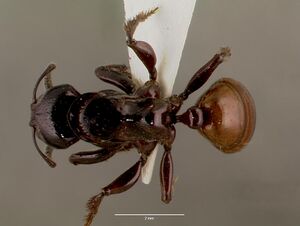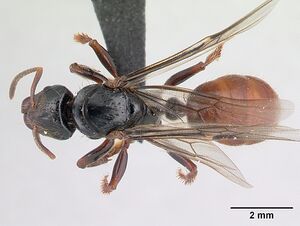Centromyrmex raptor
| Centromyrmex raptor | |
|---|---|

| |
| Scientific classification | |
| Kingdom: | Animalia |
| Phylum: | Arthropoda |
| Class: | Insecta |
| Order: | Hymenoptera |
| Family: | Formicidae |
| Subfamily: | Ponerinae |
| Tribe: | Ponerini |
| Genus: | Centromyrmex |
| Species: | C. raptor |
| Binomial name | |
| Centromyrmex raptor Bolton & Fisher, 2008 | |
The type material was collected from a Miombo woodland.
Identification
A member of the feae species group. This is the largest Afrotropical member of the genus and its mesosoma the most darkly coloured outside the bequaerti group. Its dimensions, and the characters noted in the key, make raptor easily recognisable. (Bolton and Fisher 2008)
Keys including this Species
Distribution
Latitudinal Distribution Pattern
Latitudinal Range: -12.55805556° to -18.590717°.
| North Temperate |
North Subtropical |
Tropical | South Subtropical |
South Temperate |
- Source: AntMaps
Distribution based on Regional Taxon Lists
Afrotropical Region: Zambia (type locality), Zambia (type locality), Zambia (type locality), Zimbabwe, Zimbabwe, Zimbabwe.
Distribution based on AntMaps
Distribution based on AntWeb specimens
Check data from AntWeb
Countries Occupied
| Number of countries occupied by this species based on AntWiki Regional Taxon Lists. In general, fewer countries occupied indicates a narrower range, while more countries indicates a more widespread species. |

|
Estimated Abundance
| Relative abundance based on number of AntMaps records per species (this species within the purple bar). Fewer records (to the left) indicates a less abundant/encountered species while more records (to the right) indicates more abundant/encountered species. |

|
Biology
Castes
Males have not been collected.
Worker
        
| |
| . | |
Queen
Images from AntWeb
   
| |
| Paratype of Centromyrmex raptor. Queen (alate/dealate). Specimen code casent0178746. Photographer April Nobile, uploaded by California Academy of Sciences. | Owned by CAS, San Francisco, CA, USA. |
    
| |
| Paratype of Centromyrmex raptor. Queen (alate/dealate). Specimen code casent0066882. Photographer April Nobile, uploaded by California Academy of Sciences. | Owned by CAS, San Francisco, CA, USA. |
Nomenclature
The following information is derived from Barry Bolton's Online Catalogue of the Ants of the World.
- raptor. Centromyrmex raptor Bolton & Fisher, 2008c: 21, figs. 21-24 (w.q.) ZAMBIA.
- Type-material: holotype worker (upper specimen of two on pin), 2 paratype workers, 2 paratype queens.
- Type-locality: holotype Zambia: Lusaka, Leopard Hill, 12°33.29’S, 30°17.74’E, 1300 m., 29.xi.-3.xii.2005, Miombo woodland, BLF#13554, CASENT 0066716 (B.L. Fisher, et al.); paratypes: 1 queen with same data as holotype (lower specimen on pin), 1 worker, 1 queen with same data but 13555, CASENT 0066882, 1 worker with same data but 13551, CASENT 0066707.
- Type-depository: CASC.
- Distribution: Zambia, Zimbabwe.
Unless otherwise noted the text for the remainder of this section is reported from the publication that includes the original description.
Description
Worker
Holotype. TL 9.6, HL 1.60, HW 1.94, CI 121, ML 1.32, MI 83, SL 1.30, SI 67, PW 1.56, WL 2.96.
With characters of the genus and the feae group. Masticatory margin of mandible serially dentate, with 11–12 bluntly triangular low teeth that are all about the same size; distal one-fifth of masticatory margin edentate. Mandibles heavily constructed and large, smooth with scattered small punctures. Head capsule very obviously broader than long in full-face view (range of CI 119–123). Dorsum of head with scattered punctures and with striation around the antennal fossae and on the anterior halves of the sides. Anterodorsal margination of pronotum strongly developed; margination extends around the sides almost to the posterior margin of the sclerite. Pronotal dorsum a flat plateau behind the margination. Mesonotum sharply marginate anteriorly, the margination extends along the sides above the mesopleuron. Sloping anterior portion of propodeum forms a shallow concavity basally, the posterior portion of the propodeum is slightly raised and broadly rounded behind it. Metatibia with darkly coloured spiniform setae on the apical third of the anterior surface, and with similar setae on the apical third of the dorsal surface. Orifice of propodeal spiracle much higher than wide, almost slit-shaped. Petiole node in dorsal view broader than long. Subpetiolar process short, acutely triangular. Petiolar spiracle near mid-height of anterior face of node. Prora extremely feeble, represented only by a pair of short, very low cuticular ridges on the anterior face of the first gastral sternite, on each side below the helcium; the prora hardly discernible in profile. Pronotal dorsum, and anterior mesonotum, with widely scattered broad, shallow punctures upon a weakly shagreenate surface. The mesonotum also shows weak traces of longitudinal sculpture within the marginate area. Colour predominantly mottled dull brownish red, most of dorsal mesosoma and parts of sides infuscated to blackish. Gaster more uniformly coloured and slightly lighter.
Paratypic and non-paratypic. TL 9.8-10.0, HL 1.56-1.68, HW 1.92-2.02, CI 119-123, ML 1.30-1.40, MI 82-84, SL 1.30-1.38, SI 66-69, PW 1.50-1.62, WL 2.88-3.08 (5 measured). Paratypes as holotype but the non-paratypic workers are paler in colour, with a dull yellow gaster and somewhat infuscated mesosoma, especially on the dorsum. Sculpture on the pronotal dorsum and on the mesonotum is similar to the type-series but fainter.
Queen
Paratypes. TL 10.2, HL 1.60, HW 1.88, CI 118, OI 24, ML 1.33, MI 83, SL 1.24, SI 66, PW 1.78, WL 3.20. One of the queens has two compound eyes but the other has the right eye present, the left eye entirely absent. Overall, the queens are darker in colour than the workers, the mesosoma being mostly black. The transverse mesopleural suture is conspicuous in both queens but absent from the workers. Queens will run out successfully using the key to workers.
Type Material
Holotype worker (upper specimen of two on pin, lower specimen is a dealate queen), Zambia: Lusaka, Leopard Hill, 12º33.29’S, 30º17.74E, 1300 m., 29.xi.–3.xii.2005, Miombo woodland, BLF#, 13554, CASENT 0066716 (Fisher et al.) (California Academy of Sciences).
Paratypes, 1 dealate queen with same data as holotype (lower specimen on pin); 1 worker and 1 alate queen with same data but 13555, CASENT 0066882; 1 worker with same data but 13551, CASENT 0066707 (CASC).
References
- Bolton, B. and B. L. Fisher. 2008c. Afrotropical ants of the ponerine genera Centromyrmex Mayr, Promyopias Santschi gen. rev. and Feroponera gen. n., with a revised key to genera of African Ponerinae (Hymenoptera: Formicidae). Zootaxa 1929: 1-37.
- Esteves, F.A., Fisher, B.L. 2021. Corrieopone nouragues gen. nov., sp. nov., a new Ponerinae from French Guiana (Hymenoptera, Formicidae). ZooKeys 1074, 83–173 (doi:10.3897/zookeys.1074.75551).
References based on Global Ant Biodiversity Informatics
- IZIKO South Africa Museum Collection


